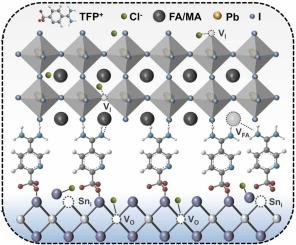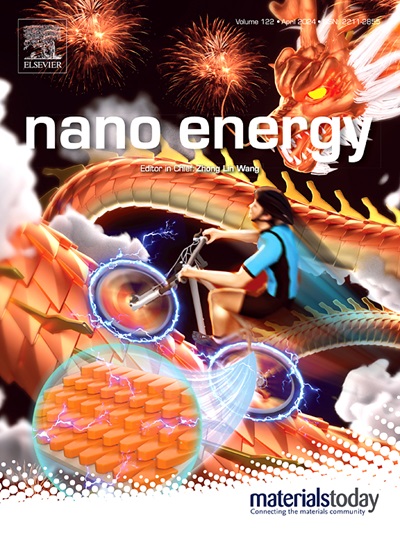实现高性能过氧化物太阳能电池的双锚偶极子埋藏界面
IF 17.1
1区 材料科学
Q1 CHEMISTRY, PHYSICAL
引用次数: 0
摘要
电子传输层(ETL)和钙钛矿活性层(PVK)之间的埋藏界面是实现高性能钙钛矿太阳能电池(PSCs)的关键。能级不匹配和界面接触不良影响了效率和稳定性。本研究引入6-(三氟甲基)吡啶-3-氨基盐化物(TFPCl)建立偶极子界面。TFPCl的引入不仅通过其偶极子特性优化了能级,便于载流子的提取和输运,而且通过双锚定加强了ETL和PVK之间的界面接触,从而增强了稳定性。钙钛矿质量的提高以及对SnO2和钙钛矿缺陷的有效钝化优化了器件的光伏性能。因此,tfpcl调制的PSC实现了25.10%的功率转换效率(PCE),并证明了1500 h的环境存储稳定性。本研究通过在ETL/PVK埋藏界面中引入偶极子分子来提高PSC的光伏性能和稳定性,这是一种简单而有效的方法。本文章由计算机程序翻译,如有差异,请以英文原文为准。

Double-anchored dipole buried interface enabling high-performance perovskite solar cells
A robust buried interface between electron transport layer (ETL) and perovskite active layer (PVK) is essential for achieving high-performance perovskite solar cells (PSCs). Energy level mismatches and poor interfacial contact hinder both efficiency and stability. In this study, we introduce 6-(trifluoromethyl)pyridine-3-amidine hydrochloride (TFPCl) to establish a dipole interface. The introduction of TFPCl not only optimizes the energy levels through its dipole characteristics, facilitating the extraction and transportation of carriers, but also reinforces the interfacial contact between ETL and PVK through dual anchoring, thereby enhancing stability. The improved perovskite quality and effective passivation of defects in SnO2 and perovskite optimized the device's photovoltaic performance. Consequently, the TFPCl-modulated PSC achieves a power conversion efficiency (PCE) of 25.10 % and demonstrates environmental storage stability of 1500 h. This study demonstrates a simple yet effective approach for enhancing the photovoltaic performance and stability of PSCs by introducing a dipole molecule into the ETL/PVK buried interface.
求助全文
通过发布文献求助,成功后即可免费获取论文全文。
去求助
来源期刊

Nano Energy
CHEMISTRY, PHYSICAL-NANOSCIENCE & NANOTECHNOLOGY
CiteScore
30.30
自引率
7.40%
发文量
1207
审稿时长
23 days
期刊介绍:
Nano Energy is a multidisciplinary, rapid-publication forum of original peer-reviewed contributions on the science and engineering of nanomaterials and nanodevices used in all forms of energy harvesting, conversion, storage, utilization and policy. Through its mixture of articles, reviews, communications, research news, and information on key developments, Nano Energy provides a comprehensive coverage of this exciting and dynamic field which joins nanoscience and nanotechnology with energy science. The journal is relevant to all those who are interested in nanomaterials solutions to the energy problem.
Nano Energy publishes original experimental and theoretical research on all aspects of energy-related research which utilizes nanomaterials and nanotechnology. Manuscripts of four types are considered: review articles which inform readers of the latest research and advances in energy science; rapid communications which feature exciting research breakthroughs in the field; full-length articles which report comprehensive research developments; and news and opinions which comment on topical issues or express views on the developments in related fields.
 求助内容:
求助内容: 应助结果提醒方式:
应助结果提醒方式:


